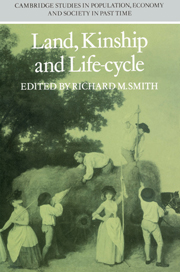Book contents
- Frontmatter
- Contents
- List of contributors
- Preface
- 1 Some issues concerning families and their property in rural England 1250–1800
- 2 Population pressure, inheritance and the land market in a fourteenth-century peasant community
- 3 Families and their land in an area of partible inheritance: Redgrave, Suffolk 1260–1320
- 4 Population changes and the transfer of customary land on a Cambridgeshire manor in the fourteenth century
- 5 Industrial employment and the rural land market 1380– 1520
- 6 Changes in the size of peasant holdings in some west midland villages 1400–1540
- 7 The erosion of the family–land bond in the late fourteenth and fifteenth centuries: a methodological note
- 8 Changes in the link between families and land in the west midlands in the fourteenth and fifteenth centuries
- 9 Kinship in an English village: Terling, Essex 1550–1700
- 10 The myth of the peasantry: family and economy in a northern parish
- 11 Poverty, poor relief and the life-cycle: some evidence from seventeenth-century Norfolk
- 12 The receipt of poor relief and family situation: Aldenham, Hertfordshire 1630–90
- 13 Widows in pre-industrial society: an essay upon their economic functions
- 14 Real property, marriage and children: the evidence from four pre-industrial communities
- 15 The nineteenth-century peasantry of Melbourn, Cambridgeshire
- Consolidated Bibliography
- Index
9 - Kinship in an English village: Terling, Essex 1550–1700
Published online by Cambridge University Press: 19 October 2009
- Frontmatter
- Contents
- List of contributors
- Preface
- 1 Some issues concerning families and their property in rural England 1250–1800
- 2 Population pressure, inheritance and the land market in a fourteenth-century peasant community
- 3 Families and their land in an area of partible inheritance: Redgrave, Suffolk 1260–1320
- 4 Population changes and the transfer of customary land on a Cambridgeshire manor in the fourteenth century
- 5 Industrial employment and the rural land market 1380– 1520
- 6 Changes in the size of peasant holdings in some west midland villages 1400–1540
- 7 The erosion of the family–land bond in the late fourteenth and fifteenth centuries: a methodological note
- 8 Changes in the link between families and land in the west midlands in the fourteenth and fifteenth centuries
- 9 Kinship in an English village: Terling, Essex 1550–1700
- 10 The myth of the peasantry: family and economy in a northern parish
- 11 Poverty, poor relief and the life-cycle: some evidence from seventeenth-century Norfolk
- 12 The receipt of poor relief and family situation: Aldenham, Hertfordshire 1630–90
- 13 Widows in pre-industrial society: an essay upon their economic functions
- 14 Real property, marriage and children: the evidence from four pre-industrial communities
- 15 The nineteenth-century peasantry of Melbourn, Cambridgeshire
- Consolidated Bibliography
- Index
Summary
The intention of this paper is simple: to provide information which may help to answer the question ‘How important was kinship in the social structure of an English village community and in the lives of English villagers in the early modern period?’ An investigation of this kind is timely, perhaps even overdue, when one considers the current stage of research in both history and the social sciences. It is now some twenty years since Professor Williams argued that ‘it does seem as if the general structure of English kinship is now clearly established’. He pointed to the general predominance of the nuclear family in household structure; the bilateral tracing of descent which gives a unique set of kin to each individual; a recognition of kin which is both shallow in depth and narrow in range. He emphasized that English kinship is ‘a flexible permissive system’ having few strong obligations or rules of behaviour between kin; that kin sentiments are rarely sufficiently strong to overcome geographical or social distance; that kinship is in general functionally unimportant as compared with neighbourliness, being merely one of several networks of connection from which individuals might select one another for various purposes.
Historians probing the very distant past might perhaps expect to discover a very different situation. Those concerned with the early modern period have long been aware of the preoccupation with lineage and of the effective importance of kinship ties among the ruling class of the time.
- Type
- Chapter
- Information
- Land, Kinship and Life-Cycle , pp. 313 - 332Publisher: Cambridge University PressPrint publication year: 1985
- 3
- Cited by

